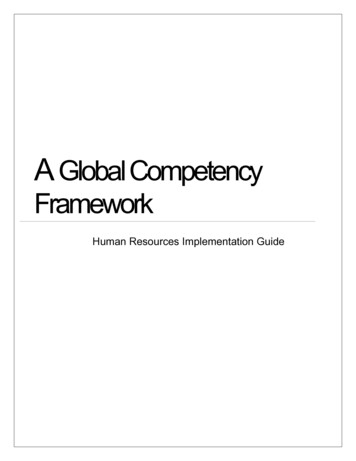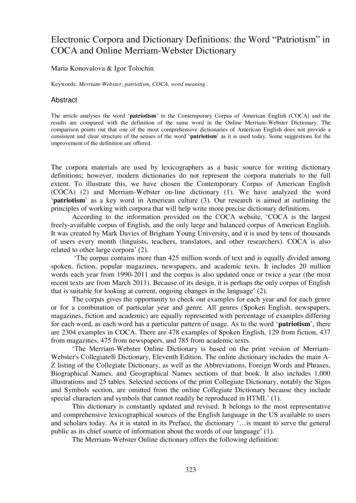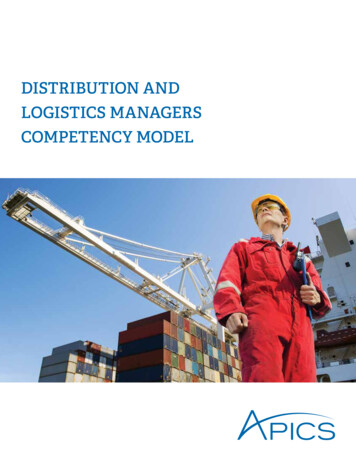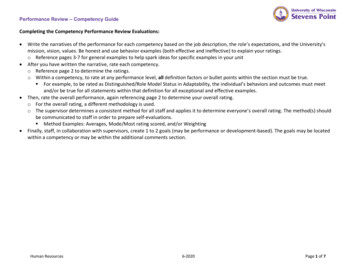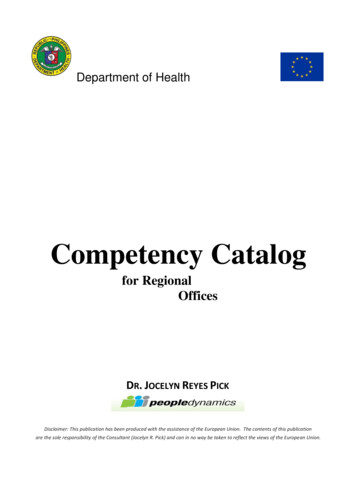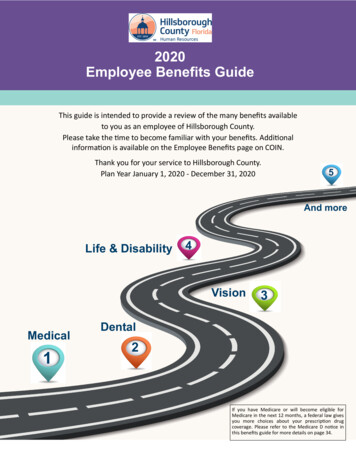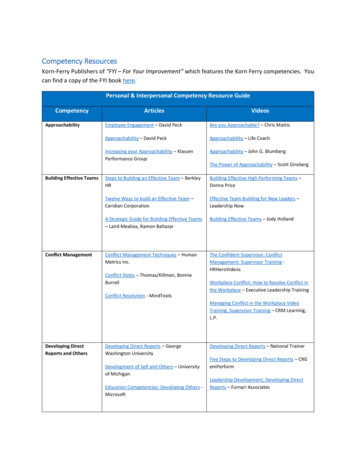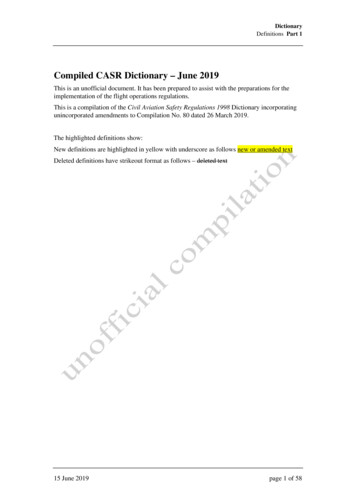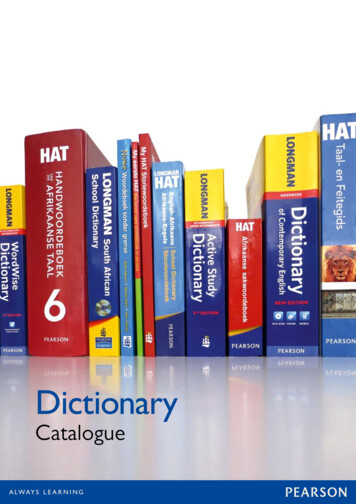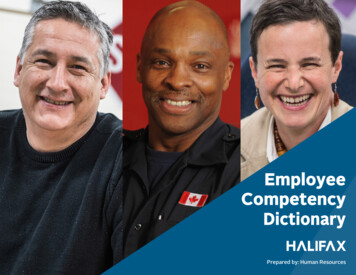
Transcription
EmployeeCompetencyDictionaryPrepared by: Human Resources
Table of ContentsWhat are Competencies?. 4“How we do what we do” .4How Are the Competencies Structured? .4How to use this dictionary? . 6As an employee .6As a supervisor: .6Analytical Thinking . 7Communications . 8Conflict Management . 9Customer Service . 10Decision Making . 11Developing Others . 12Managing Change. 13Networking / Relationship Building . 14Organization and Planning . 15Organizational Awareness. 16Human Resources Employee Competency Dictionary2
Risk Management . 17Teamwork and Cooperation . 18Values and Ethics . 19Valuing Diversity . 20Visioning, Strategic Thinking and Innovation. 21Human Resources Employee Competency Dictionary3
What are competencies?“How we do what we do”Competencies are observable abilities, skills, knowledge, motivations or traits defined in terms of the behaviours needed forsuccessful job performance.How are competencies structured?Each competency has proficiency levels which are described in terms of behavioural indicators. Competencies are mapped tospecific employees and their expected progression levels. There are 15 competencies that have been analyzed for relevancyand uniqueness to the needs of the municipality. These competencies were based on the organization’s needs assessed as aresult of interviews, focus groups, and staff surveys.There are three levels in each competency, these include: 1-Beginner, 2-Intermediate, and 3-Expert. The Beginner levelindicates an entry level mastery of the competency, with more experience needed to fully develop the competency needed. TheIntermediate level indicates an employee who shows more mastery of the competency, and has progressed from an entry levelunderstanding of the competency. The Expert level includes employees who have significantly mastered the competency andanticipate the need to use the competency.This competency dictionary has been updated to reflect the new Learning and Development Framework which aligns to theStrategic Pillars of the organization.Human Resources Employee Competency Dictionary4
The above diagram graphically depicts the municipality’s Key Competency Profiles.All Employees - The first row shows competencies that should be demonstrated by all municipal employees.Professional/Technical - The second row lists competencies that could be demonstrated by any employee and should bedemonstrated by professional/technical staff and leaders.Leaders - The third row shows competencies that could be demonstrated by any employee and should be demonstrated byleaders.Human Resources Employee Competency Dictionary5
How to use this dictionary?As an employee:The contents of this dictionary represent the behavioural or non-technical competencies that apply to all jobs within themunicipality. Some of the competencies may vary from position-to-position and level of complexity required for specificleadership or technical roles. For employees required to complete the annual learning and development tool, My Action Plan(MAP), the Competency Dictionary will be used to assist you in completing the plan. MAP is a key component for aligninglearning needs to the business unit’s organizational goals and supporting employee growth within the organization.As a supervisor:Once your business unit has established the operational plans and priorities for the year, supervisors can meet with theiremployees and determine which competencies are required to help achieve the operational goals (work objectives), as well asthe overall growth goals (learning objectives) of the employee. Working with each employee and using the descriptions in thisdictionary, establish the level of proficiency you are expecting to be achieved by the employee for each competency. Dependingon the objectives identified, you may then assist the employee in choosing appropriate courses that align to the competencyusing the training catalogue or other resources.Human Resources Employee Competency Dictionary6
Analytical ThinkingUnderstanding a situation by breaking it apart into smaller pieces, or tracing the implications of a situation in a step-by-step way. Thisincludes organizing the parts of a problem, situation, etc., in a systematic way; making systematic comparisons of different features oraspects; setting priorities on a rational basis.Level 1Analyzes and synthesizes informationand sees some relationships Breaks down problem into simple lists oftasks or activities. Gathers inputs from appropriate sources ofinformation.Level 2Analyzes complex relationshipsand applies broad analysis Systematically breaks down a complex problemor process into component parts. Uses severaltechniques to break apart complex problems toreach a solution. Recognizes and assesses several likelycausal factors or ways of interpreting theinformation available.Identifies connections between situations thatare not obviously related. Identifies the links between situations andinformation. Sees connections, patterns or trends in theinformation available. Identifies the potential effect of trends orevents. Integrates information from diverse sources,often involving large amounts of information. Draws logical conclusions, providingoptions and recommendations. Thinks several steps ahead in deciding onbest course of action, anticipating likelyoutcomes. Develops and recommends policy frameworkbased on analysis of emerging trends.Human Resources Employee Competency DictionaryLevel 3Applies a whole systems perspectiveto analysis Identifies multiple relationships anddisconnects in processes in order to identifyoptions and reach conclusions. Adopts a whole systems perspective,assessing and balancing vast amounts ofdiverse information on the varied systemsand sub- systems that comprise and affectthe working environment. Thinks beyond the organization and into thefuture, balancing multiple perspectives whensetting direction or reaching conclusions (e.g.,social, economic, partner, stakeholderinterests, short- and long-term benefits,national and global implications).7
CommunicationsCommunication is effective, timely, and relevant exchange of information that is respectful of the diversity of people, and thegeography and working environments of our employees. It includes receiving information, listening, understanding and respondingopenly and effectively in interactions with others. It also implies this information is processed into actions.Level 1Listens & clearly presentsinformation Makes self available and clearlyencourages others to initiatecommunication. Listens actively and objectivelywithout interrupting. Pays attention to thecommunication of others. Listensand takes notes where appropriate;and accurately delivers information. Seeks to ensure that factualmessages are clearly understood,useful and timely. Picks up on nonverbal clues.Is receptive and responds in waysthat communicate clearunderstanding.Level 2Adapts communication to others and communicates complexmessages Adapts content, style, tone and medium of communication to suit the targetaudience’s language and level of understanding. Takes others’ perspectives into account when communicating, negotiatingor presenting arguments. Presents written oral and written communications with confidence andclarity. Keeps individual or groups current on any action taken and shares allrelevant information. Develops communication action plans within theirspan of control and/or shows commitment to employees by developing anappropriate mechanism(s) for staff to bring forth thoughts, comments,ideas or concerns. Handles complex on-the-spot questions (e.g., from senior public officials,special interest groups or the media). Communicates complex issues clearly and credibly with widely variedaudiences. Elicits comments or feedback onwhat has been said. Adapts style, message and tone based on the audience or client group andon the particular issues being addressed. Maintains continuous open andconsistent communication withothers. Facilitates open communication and information exchange. Contributes to an atmosphere in which timely and high quality informationflows smoothly; encourages the open expression of ideas and opinions. Persuades others through presentations and debate to adopt a course ofaction that they are advancing.Human Resources Employee Competency DictionaryLevel 3Communicates strategically Communicates strategically toachieve specific objectives (e.g.,considering such aspects as theoptimal message to present,timing and forum ofcommunication). Uses varied communicationvehicles and opportunities topromote dialogue, sharedunderstanding and consensus. Understands the underlyingneeds, interests, issues andmotivations of others. Interpretscomplex and possiblycontradictory or competingsignals/messages.8
Conflict ManagementFacilitating the prevention, management and/or resolution of conflicts.Level 1Notices and addresses conflict Recognizes there is a conflict between two ormore parties. Level 2Addresses potential conflict andintroduces resolution strategiesLevel 3Creates an environment whereconflict is resolved positively Brings conflict to the attention of the appropriateindividual(s) while respecting their points ofview.Anticipates and takes action to avoid / reducepotential conflict (e.g., by encouraging andsupporting the various parties to get togetherand attempt to address the issues themselves).Creates a conflict-resolution environmentby anticipating and addressing areaswhere potential misunderstanding anddisruptive conflict could emerge. Refocuses teams on the work and end-goals,and away from personality issues. Listens to differing points of view and promotesmutual understanding. Provides consultation to or obtains consultation /mediation for others who share few/limitedcommon interests.Models constructive approaches to deal withopposing views when personally challengingthe status quo and when encouraging othersto do so as well. Introduces innovative strategies for effectivelydealing with conflict (e.g., mediation,collaborative and “mutual gains” strategies).Openly identifies shared areas of interest in arespectful and timely manner.Human Resources Employee Competency Dictionary9
Customer ServiceImplies a desire to help or serve others, to meet their needs. It means focusing one’s efforts on discovering and meeting the customeror client’s needs. “Customers” include internal colleagues, citizens, elected officials or anyone that the person is trying to help.Level 1Level 2Evaluates and adapts to client needs andfosters a client-focused cultureResponds to client requests Meets client needs by responding torequests efficiently and effectively. Maintains ongoing communications with clients toanticipate and prevent potential problems. Meets client needs in a professional,helpful and responsive manner. Regularly, pro-actively and systematically contactsclients or prospective clients to determine theirneeds. Seeks clear understanding of client needsand outcomes. Adapts services, products or solutions to meet client needs. Contacts clients to follow up on services,or products to ensure their needs havebeen correctly and effectively met. Make concrete attempts to add value to the client, tomake things better for the client in some way. Expressespositive expectations about the client. Seeks to understand issues from theclient’s perspective. Keeps clients current with information anddecisions that affect them.Seeks information about the real, underlying needs ofthe client, beyond those expressed initially, andmatches these to available (or customized) products orservices. Takes personal responsibility for correctingcustomer- service problems. Correctsproblems promptly. Ensures the tracking of trends and developments that willaffect own organizations’ ability to meet current andfuture client needs. Identifies benefits for clients, looks for ways to add value. Looks for opportunities to save money or resources forclient. Seeks out and involves clients or prospective clients inassessing services, solutions or products to identifyways to improve.Human Resources Employee Competency DictionaryLevel 3Considers the strategic direction ofclient focus Strategically and systematicallyevaluates new opportunities todevelop client relationships. Secures a comprehensive and indepth understanding of clients’ longterm needs and strategies. Recommends/determines strategicbusiness direction to meet projectedneeds of clients and prospective clients. Regularly solicits feedback regardingquality of customer service delivered byteam and self. Emphasizes the need to deliver qualityproducts/ services; defines standards forquality and evaluates processes orservices against those standards;manages quality and cost effectiveness.10
Decision MakingMaking decisions involving varied levels of risk and ambiguity.Level 1Makes decisions based on interpreting rules Applies explicit guidelines and procedures inmaking decisions. Makes straightforward decisions based onadequate information.Level 2Makes decisions in vague situations Applies guidelines and procedures that leaveconsiderable room for discretion andinterpretation. Makes decisions by weighing several factors,some of which are partially defined and entailmissing pieces of critical information.Level 3Makes high-risk decisionsin the face of ambiguity Makes high-risk strategic decisions that havesignificant consequences. Uses principles, values and soundbusiness sense to make decisions. Makes decisions in a volatile environment inwhich the weight given to any factor canchange rapidly. Makes decisions by taking into account thedifferences across team members, andoverall team requirements and objectives. Deals with exceptions using clearly specified rules. Makes decisions involving little or noconsequence of error. As needed, involves the right people in thedecision making process. Applies guidelines and procedures that requiresome interpretation in dealing withexceptions. Makes complex decisions for which there is noset procedure. Makes straightforward decisions based oninformation that is generally adequate.Considers a multiplicity of interrelated factors forwhich there is incomplete and contradictoryinformation. Ensures team members affected by adecision know exactly what is happeningand gives a clear rationale for the decision. Makes decisions involving minorconsequences of error. Balances competing priorities in reachingdecisions. Guides teams to make decisions (andmistakes) that reflect awareness toorganization consequences. Seeks guidance as needed when thesituation is unclear. Provides valued advice for Council to makedecisions that best reflect the needs of theorganization and community.Human Resources Employee Competency Dictionary11
Developing OthersInvolves a genuine intent to provide leadership by fostering the long-term learning or development of others based on operationalneeds and future aspirations. Focuses on analyzing areas for improvement and enhancing areas of strength to assist others inreaching their full potential. Effort expended goes beyond simply sending people to formal training programs.Level 1Shares expertise with others and supportsindividual development and improvement Regularly shares expertise with team membersto support continuous learning and improvement. Advises, guides and coaches others by sharingexperiences and discussing how to handlecurrent or anticipated concerns. Makes positive comments regarding others’abilities or potential even in difficult cases.Believes others want to and can learn or improvetheir performance.Level 2Coaches others and provides the means forteam development Provides regular feedback and guidance to helpteam members achieve the outcomes of theirperformance plan. Provides long-term direction regardinglearning needs for staff and how topursue the attainment of this learning. Works with employees and teams to define realisticyet challenging work goals. Institutes organization-wide mechanismsand processes to promote and supportcontinuous learning and improvement. Gives detailed instructions and/or on the jobdemonstrations, tells how to do the task, makesspecific helpful suggestions. Facilitates the involvement of externalparties to contribute to the achievementof organizational goals. After assessing subordinates’competence, delegates full authority andresponsibility with the latitude to do atask in their own way, including theopportunity to make and learn frommistakes in a non-critical setting. Promotes or arranges promotions forespecially competent subordinates as areward or a developmental experience;or gives other recognition for goodperformance or excellence. Level 3Cr eat es a cont inuous l ear ni ngand developm ent envi r onm entEnsures that resources and time are available fordevelopment activities.Provides performance feedback and support,reinforcing strengths and identifying areas forimprovement. Ensures that all employees have equitable accessto development opportunities.Encourages staff to develop and apply theirskills. Provides opportunities for development throughtools, assignments, etc.Suggests to individuals ways of improvingperformance and competence. Provides mentorship to others and oversight to theachievement of goals.Ensures that team members have the necessaryinformation to operate effectively. Leads processes by which teams discuss anddetermine their unique attributes and contributionto the organization. Provides constructive feedback and recognizescontributions.Human Resources Employee Competency Dictionary12
Managing ChangeManaging and facilitating the process of change and transition while helping others deal with their effects.Level 2Manages the process for changeand maintains alignment withorganizational objectivesLevel 1Makes others aware of change Identifies and accepts the need and processes forchange. Explains the process, ramifications and rationalefor change to those affected by it. Invites discussion of views on the change. Clarifies the potential opportunities andconsequences of proposed changes. Identifies important / effective past practicesthat should continue after change isimplemented. Anticipates specific reasons underlyingresistance to change and implementsapproaches that address resistance. Ensures that change does not derail progresstoward identified objectives. Clarifies the potentialopportunities and consequencesof proposed changes.Human Resources Employee Competency DictionaryLevel 3Champions change Creates an environment that promotes andencourages change or innovation. Shares and promotes successfulchange efforts throughout theorganization. Personally communicates a clear vision ofthe broad impact of change. Builds commitment for new initiatives.13
Networking / Relationship BuildingSeeking strategic alliances, and maintaining working relationships and/or networks of contacts to further the organization’s goals.Strengthening relationships within teams and recognizing and cultivating strategic linkages between groups.Level 1Accesses known sources ofinformation and personal contacts,manages existing relationships Seeks information from others (e.g.,colleagues, customers). Maintains personal list of contacts, in otherparts of the organization, who can providework-related information. Builds rapport by frequently initiatinginformal or casual contacts at work withassociates or customers. Seeks opportunities to partner and transferknowledge (e.g., by actively participating intrade shows, conferences, meetings,committees, multi-stakeholder groups and/orseminars). Creates and facilitates forums to developnew alliances and formal networks. Identifies areas to build strategicrelationships. Cultivates personal networks in different partsof the organization and effectively usescontacts to achieve results. Contacts senior officials to identify potentialareas of mutual, long-term interest. Builds networks with parties that canenable the achievement of theorganization’s strategy.Profiles excellent examples of partnerarrangements throughout the organization. Establishes credibility with internal andexternal stakeholders Ensures that appropriate linkages /partnerships between teams are maintained.Develops and nurtures key contacts as asource of information.Participates in networking and socialevents internal and external to theorganization.Level 3Creates strategic directionfor partnering andnetworking opportunitiesLevel 2Seeks out new networkingand partnership opportunitiesfor self and others Bring informal teams of experts together toaddress issues/needs, share information andresolve differences, as required. Sets an example for others (e.g., respect of others’views, team loyalty, cooperating with others). Seeks out the expertise of others and developslinks with experts and information sources.Human Resources Employee Competency Dictionary14
Organization and PlanningThe ability to effectively plan and organize one’s time to: achieve goals, prioritize tasks and allocate time and resources accordingly toensure completion; to manage multiple tasks and organize time accordingly, and to make use of resources available to assist inachieving these goals.Level 1Uses formal and informal systems toachieve business / work objective Identifies requirements and uses resourcesto meet own objectives in optimal fashion. Plans and organizes one’s own work. Level 2Develops plans for the business unitand effectively organizes others Considers a range of factors in the planningprocess (e.g., costs, timing, customer needs,resources available, etc.). Identifies and plans activities that will result inoverall improvement to services. Establishes alternative courses of action,organizes people and prioritizes activities of theteam to achieve results more effectively.Monitors the attainment of own objectivesand/or quality of the work completed.Efficiently uses available resources tocomplete tasks, creates own action plan,sets realistic time frames and deadlinesfor assignments.Identifies importance of tasks and prioritizestime accordingly to ensure completion of alltasks within time frame, able to establishcourse of action for oneself, utilizes tools (e.g.,Day-Timer, Outlook, Priority Manager) to keeporganized. Evaluates processes and results andmakes appropriate adjustments to theplan. Sets, communicates and monitors prioritiesfor activities. Ensures that systems are in place toeffectively monitor and evaluate progress.Level 3Plans and organizes at astrategic level Plans work and deploys resources todeliver organization wide results. Secures and allocates program or projectresources in line with strategic direction. Sets and communicates priorities withinthe broad organization. Ensures sufficient resources are availableto achieve set objectives. Leads processes to maintainorganizational attention to strategicpriorities amidst competing demands.Makes needed adjustments to timelines, steps and resource allocation.Human Resources Employee Competency Dictionary15
Organizational AwarenessThe ability to understand and learn the power relationships in one’s own organization or in other organizations (customers, suppliers,etc.). In municipal government this includes the understanding and adherence to the requirements of enabling legislation as well asthe understanding of the political process and the roles of elected officials. It also includes the ability to identify who are the realdecision makers and the individuals who can influence them; and to predict how new events or situations will affect individuals andgroups within the organization.Level 1Understands formal / informal structureand culture Understands the basic accountabilities of theorganization. Level 2Effectively operates in external environmentsand understands organizational politics,issues and external influences Achieves solutions acceptable to varied partiesbased on understanding of issues, climates andcultures in own and other organizations.Recognizes and uses formal structure, rules,processes, methods or operations to accomplishwork. Understands issues and cultures externalto the organization. Understands the Public Sector context. Anticipates issues, challenges and outcomes andeffectively operates to best position the organization. Has a good understanding of the unwritten, informalstructure, culture and rules. Effectively uses both formal and informal channelsand networks for acquiring information, assistanceand accomplishing work goals.Supports the changing culture and methods ofoperating, if necessary for the success of theorganization. Ensures due diligence by keeping informed ofbusiness and operational plans and practices. Understands, and addresses, the reasons for ongoing organizational behaviour or the underlyingproblems, opportunities or political forces affectingthe organization. Delivers advice and services that are valued bymanagement based on a keen sensitivity to thepolitical needs of Council. Recognizes unspoken organizational constraints what is and is not possible at certain times or incertain positions. Recognizes and uses thecorporate culture and the language that will yieldthe best response.Human Resources Employee Competency DictionaryLevel 3Operates effectively in a broadspectrum of political, culturaland social milieu Demonstrates broad understandingof social and economic contextwithin which the organizationoperates. Understands and anticipates thepotential trends of the politicalenvironment and the impact thesemight have on the organization. Operates successfully in a varietyof social, political and culturalenvironments.16
Risk ManagementIdentifying, assessing and managing risk while striving to attain objectives.Level 1Personally takes risks and supportsrisk taking by othersLevel 2Personally takes significant risks andleads high-risk initiativesLevel 3Provides organizational guidanceon risk Publicly supports responsible risk taking byothers. Provides an environment that supportsresponsible risk taking (e.g., by supportingdecisions of others). Anticipates, identifies and effectively dealswith problems or risks.Personally takes calculated risks withsignificant consequences (e.g., significantloss of time or money which can berectified). Conducts ongoing risk analysis, lookingahead for contingent liabilities andopportunities and astutely identifying therisks involved.Oversees the development of guidelines,principles and approaches to assistdecision - making when risk is a factor. Provides guidance on the organizationaltolerance for risk. Develops broad strategies that reflect indepth understanding and assessment ofoperational, organizational, and politicalrealities and risks. Plans for contingencies. Takes calculated risks with minor, but nontrivial, consequences of error (e.g., risksinvolving potential loss of some time or moneywhich can b
Human Resources Employee Competency Dictionary 7 Analytical Thinking . Understanding a situation by breaking it apart into smaller pieces, or tracing the implications of a situation in a step-by-step way. This includes organizing the parts of a problem, situation, etc., in a systematic wa

